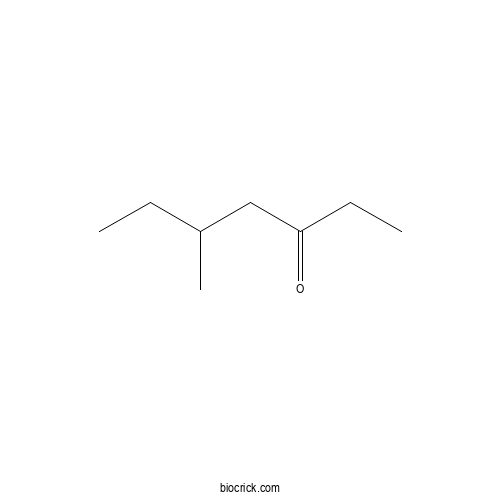5-Methyl-3-heptanoneCAS# 541-85-5 |

Quality Control & MSDS
3D structure
Package In Stock
Number of papers citing our products

| Cas No. | 541-85-5 | SDF | Download SDF |
| PubChem ID | 7822 | Appearance | Oil |
| Formula | C8H16O | M.Wt | 128.2 |
| Type of Compound | Miscellaneous | Storage | Desiccate at -20°C |
| Solubility | Soluble in Chloroform,Dichloromethane,Ethyl Acetate,DMSO,Acetone,etc. | ||
| Chemical Name | 5-methylheptan-3-one | ||
| SMILES | CCC(C)CC(=O)CC | ||
| Standard InChIKey | PSBKJPTZCVYXSD-UHFFFAOYSA-N | ||
| Standard InChI | InChI=1S/C8H16O/c1-4-7(3)6-8(9)5-2/h7H,4-6H2,1-3H3 | ||
| General tips | For obtaining a higher solubility , please warm the tube at 37 ℃ and shake it in the ultrasonic bath for a while.Stock solution can be stored below -20℃ for several months. We recommend that you prepare and use the solution on the same day. However, if the test schedule requires, the stock solutions can be prepared in advance, and the stock solution must be sealed and stored below -20℃. In general, the stock solution can be kept for several months. Before use, we recommend that you leave the vial at room temperature for at least an hour before opening it. |
||
| About Packaging | 1. The packaging of the product may be reversed during transportation, cause the high purity compounds to adhere to the neck or cap of the vial.Take the vail out of its packaging and shake gently until the compounds fall to the bottom of the vial. 2. For liquid products, please centrifuge at 500xg to gather the liquid to the bottom of the vial. 3. Try to avoid loss or contamination during the experiment. |
||
| Shipping Condition | Packaging according to customer requirements(5mg, 10mg, 20mg and more). Ship via FedEx, DHL, UPS, EMS or other couriers with RT, or blue ice upon request. | ||
| Description | 5-Methyl-3-heptanone is a sex pheromone, can coordinate reproductive behaviour. | |||||

5-Methyl-3-heptanone Dilution Calculator

5-Methyl-3-heptanone Molarity Calculator
| 1 mg | 5 mg | 10 mg | 20 mg | 25 mg | |
| 1 mM | 7.8003 mL | 39.0016 mL | 78.0031 mL | 156.0062 mL | 195.0078 mL |
| 5 mM | 1.5601 mL | 7.8003 mL | 15.6006 mL | 31.2012 mL | 39.0016 mL |
| 10 mM | 0.78 mL | 3.9002 mL | 7.8003 mL | 15.6006 mL | 19.5008 mL |
| 50 mM | 0.156 mL | 0.78 mL | 1.5601 mL | 3.1201 mL | 3.9002 mL |
| 100 mM | 0.078 mL | 0.39 mL | 0.78 mL | 1.5601 mL | 1.9501 mL |
| * Note: If you are in the process of experiment, it's necessary to make the dilution ratios of the samples. The dilution data above is only for reference. Normally, it's can get a better solubility within lower of Concentrations. | |||||

Calcutta University

University of Minnesota

University of Maryland School of Medicine

University of Illinois at Chicago

The Ohio State University

University of Zurich

Harvard University

Colorado State University

Auburn University

Yale University

Worcester Polytechnic Institute

Washington State University

Stanford University

University of Leipzig

Universidade da Beira Interior

The Institute of Cancer Research

Heidelberg University

University of Amsterdam

University of Auckland

TsingHua University

The University of Michigan

Miami University

DRURY University

Jilin University

Fudan University

Wuhan University

Sun Yat-sen University

Universite de Paris

Deemed University

Auckland University

The University of Tokyo

Korea University
- 3-Methyl ellagic acid
Catalog No.:BCN9902
CAS No.:51768-38-8
- Bufotenine
Catalog No.:BCN9901
CAS No.:487-93-4
- Methyl benzoate
Catalog No.:BCN9900
CAS No.:93-58-3
- cis-Jasmone
Catalog No.:BCN9899
CAS No.:488-10-8
- Dihydroisoferulic acid
Catalog No.:BCN9898
CAS No.:1135-15-5
- 3',4'-Dimethoxyflavone
Catalog No.:BCN9897
CAS No.:4143-62-8
- Decanoic acid
Catalog No.:BCN9896
CAS No.:334-48-5
- 3-Octanone
Catalog No.:BCN9895
CAS No.:106-68-3
- Methyl anthranilate
Catalog No.:BCN9894
CAS No.:134-20-3
- (-)-Linalool
Catalog No.:BCN9893
CAS No.:126-91-0
- 5-Geranoxy-7-methoxycoumarin
Catalog No.:BCN9892
CAS No.:7380-39-4
- Caffeoyl alcohol
Catalog No.:BCN9891
CAS No.:3598-26-3
- 3-O-Acetyl 9,11-dehydro beta-boswellic acid
Catalog No.:BCN9904
CAS No.:122651-20-1
- Eupalitin
Catalog No.:BCN9905
CAS No.:29536-41-2
- Eupalitin 3-galactoside
Catalog No.:BCN9906
CAS No.:35399-32-7
- Calycopterin
Catalog No.:BCN9907
CAS No.:481-52-7
- Epoxybergamottin
Catalog No.:BCN9729
CAS No.:206978-14-5
- Corynanthine
Catalog No.:BCN9910
CAS No.:483-10-3
- 5-Methoxypiperonal
Catalog No.:BCN9911
CAS No.:5780-07-4
- (R)-O-isobutyroyllomatin
Catalog No.:BCN9912
CAS No.:440094-38-2
- Daucoidin A
Catalog No.:BCN9913
CAS No.:103629-87-4
- (-)-Sparteine
Catalog No.:BCN9914
CAS No.:90-39-1
- Tigogenin acetate
Catalog No.:BCN9915
CAS No.:2530-07-6
- Crotonic acid
Catalog No.:BCN9916
CAS No.:107-93-7
In vitro quantitative structure-activity relationship assessment of pyrrole adducts production by gamma-diketone-forming neurotoxic solvents.[Pubmed:20650157]
Toxicol In Vitro. 1995 Oct;9(5):783-7.
Organic solvents that are metabolically transformable into gamma-diketones produce central- peripheral distal axonopathy. One of the mechanisms proposed to explain the development of this neuropathy has been the formation of pyrrole adducts between gamma-diketone metabolites and -amine groups of lysine residues on the neuronal cytoskeletal proteins. In vivo studies on the neurotoxic capability of different solvents, derivatives of n-hexane and n-heptane, have previously established the quantitative structure-activity sequence. An in vitro assay for the quantification of pyrrole adduct formation is reported here that allows prediction of neurotoxic potency, using an index of neurotoxic potential. The kinetics of pyrrole adduct formation was established by incubation of each solvent with a purified microsomal fraction of liver from rats preinduced with phenobarbital. The solvents assayed in the in vitro system were 2-hexanone, 3,4-dimethylhexane, 2,5-hexanedione, 3,4-dimethyl-2,5-hexanedione, 2-hexanol and 2,5-hex- anediol as derivatives of n-hexane; and 4-heptanone, 5-Methyl-3-heptanone, 6-methyl-2,4-heptanedione and 4-heptanol as derivatives of n-heptane. The results indicate good correlation between neurotoxic potency in vivo and quantitative production of adducts in vitro with both n-hexane and n-heptane derivatives.


